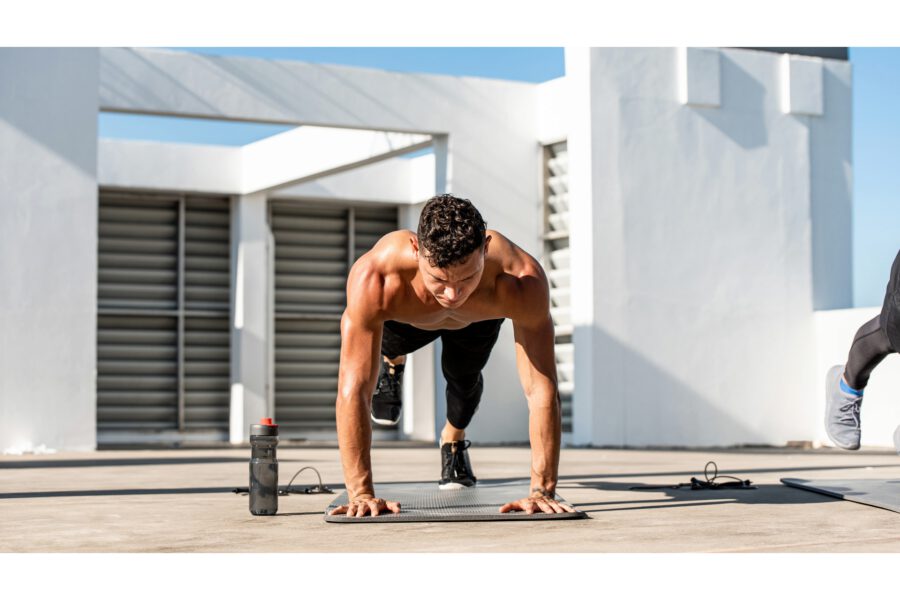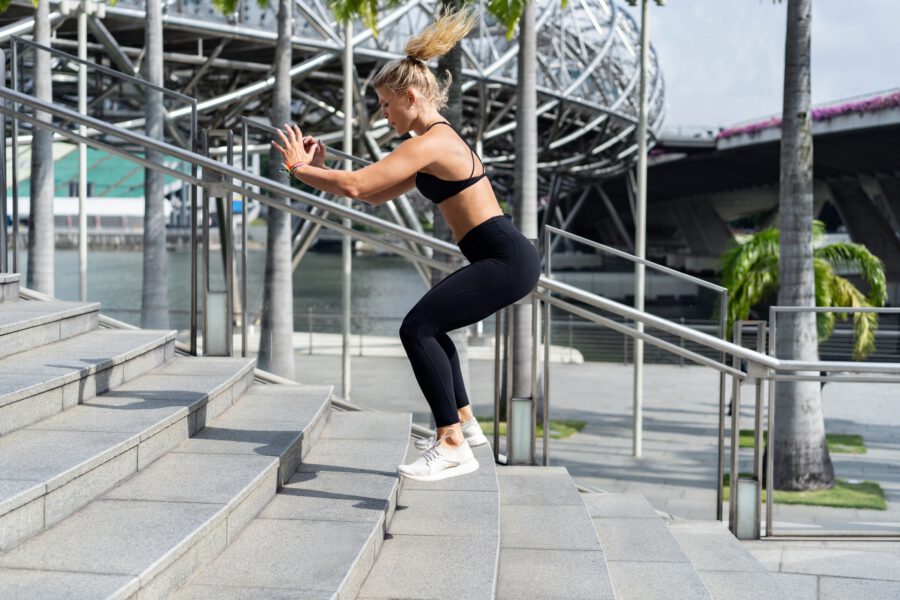Best HIIT Protocols to Lose Fat and Get Lean Muscle Mass
Want to get the maximum effectiveness from your exercise investment?
Only got limited time and equipment to work out?
Looking to optimize your calorie burn for weight loss?
HIIT workouts are the perfect solution.
Maybe you’ve heard of HIIT. It’s been around since the late 1990s and has really gained traction in the past few years. More and more people are discovering that HIIT provides exactly what they want from a workout …
- It’s quick
- It’s intense
- It burns a ton of calories
- It can be done anywhere
- It boosts your metabolism post-workout
HIIT is especially beneficial for people who work out at home. It can be done with very little equipment. In fact, many HIIT workouts do not use any equipment at all.
HIIT workouts require very little space. And they are extremely time-poor friendly. In fact, you can get a super effective HIIT workout done in just 8 minutes, and that includes 4 minutes of warming up and cooling down!
In this article, we reveal why HIIT is so effective. We will then analyze the best HIIT protocols.
HIIT stands for high-intensity interval training. When you do a HIIT workout, your body constantly shifts between bursts of intense physical activity - made up of a blend of strength exercise and cardio - and short periods of recovery.
Research confirms that the fast and furious HIIT exercise method is far more effective at burning calories and fat than hours of moderate to low-intensity steady-state cardio. A key reason is that HIIT workouts keep the body guessing.
When you do extended steady-state cardio workouts done at the same pace and with the same amount of effort, your body quickly adjusts and reaches a metabolic state designed to conserve energy. By contrast, because HIIT causes your heart rate and energy output to fluctuate throughout an exercise session, the body is unable to find this steady state. As a result, its calorie-burning energy needs remain at a higher rate.
HIIT workouts are much shorter than steady-state cardio workouts. They are usually completed within 10-15 minutes. Despite this, they are more effective at burning calories than a long, steady session on a treadmill or elliptical. The main reason for this is that the combination of bursts of maximal effort with frequent short rests, causes an extended recovery period of what scientists called Excess Post-exercise Oxygen Consumption (EPOC). It is commonly known as the afterburn effect.
In order to power the muscular contractions that are needed to perform your HIIT workout, the body converts stored glucose to molecules of Adenosine Triphosphate (ATP). The main mode of conversion requires the presence of oxygen in the chemical reaction, which is supplied via the cardiovascular system.
Yet, even after the workout is over, your body has an elevated need for energy - and, therefore, oxygen - in order to fuel various processes that replenish lost glycogen stores and generally return the body to homeostatic balance. This recovery period is when excess post-exercise oxygen consumption occurs to facilitate the body’s raised metabolism while it adjusts down to a state of rest.
To supply those extra oxygen demands, the body has to work harder. As a result, the metabolism is elevated.
The duration of EPOC after a short HIIT workout is far longer than after an extended session of even more steady-state aerobic exercise. This elevates your metabolism by as much as 30% within a couple of hours after the workout.
There are many different ways to do HIIT. As a personal trainer, I’ve experimented with them all. When it comes to building a lean, muscular physique, there are four HIIT methods that stand out to me.
Tabata workouts involve doing a 20-second burst of all-out effort followed by a 10-second rest. This is repeated for 8 rounds.
Tabata was the original HIIT protocol developed by Japanese Olympic Speed Skating Coach Azumi Tabata. He trialed the program with his athletes on exercise bikes, but the protocol can be used with any form of exercise that allows you to go all out for a fast burst of activity.
The workout involves just 4 minutes of work. Yet, within that short space of time, Tabata’s athletes were able to burn more calories than they had previously been burning in 30 minutes of steady-state exercise.
Tabata workouts should begin with a 2-minute warm-up and conclude with a similar cool-down period. Beginners should do just one round, for a total exercise time of 8 minutes. Over time, additional 4 minute sprint/rest circuits can be added. In this case, you should rest up to 5 minutes between each circuit.
The key to success with Tabata HIIT is to perform your 20-second sprint sessions with all-out effort. If your workout involves running, imagine that you’re being chased by a very hungry Rottweiler!
For each successive sprint round, make it your goal to maintain the same intensity level as on the previous sprint. Make sure, also to keep strictly to the 20-second on /10 seconds off time schedule.
At the end of your Tabata session, you should be totally exhausted. Yet, that few minutes of exercise will have set you up to torch body fat for the next 16-24 hours!
Pros:
- Short, explosive sprint sessions.
- Short and intense.
Cons:
- Cardio sprints are too short to build cardio endurance.
EMOM stands for ‘Every Minute on the Minute’. It involves doing a set number of reps within a sixty-second time frame and then resting for the remainder of that minute. At the start of the next minute, you go into your next exercise.
The number of reps can either remain the same or decrease as the minutes progress. You can also do EMOM training with the same exercise, or with a circuit of different exercises.
Another way to do EMOM is, rather than training to a rep count, to to keep doing the exercise for time. Beginners could set their stopwatch to beep every 30 seconds, so that they do the exercise for 30 seconds and then rest for 30 seconds. As your fitness level increases, extend the exercise time to 45 seconds so that you only have 15 seconds of rest before starting the next exercise.
Pros:
- Allows you to focus on a target rep count each time you do the sprint portion.
- Progressive - as you get fitter, decrease the rest time.
Cons:
- Not ideal for resistance exercises.
With this method your high intensity portion is extended to four minutes. During this time, you should be working at 80-90% of your maximum heart rate. You then do 3 minutes of active recovery at around 60% of max heart rate.
This process is completed in four rounds.
Pros:
- Greatest cardiovascular benefit.
- High calorie burn
Cons:
- 4 minutes of intense cardio may be too hard for many people
Here’s a HIIT workout you should try:
Strength Training HIIT provides an ideal balance between intense cardio and resistance training to work both the aerobic and anaerobic systems at the same time. It is done in AMRAP style. That stands for ‘as many as reps as possible’.
During the sprint period, you will do as many reps as possible in 45 seconds. You will then have 15 seconds to rest. Here is my favorite version of this workout, done for four rounds:
- 45 seconds of shadow punching with light dumbbells in your hands.
- 15 seconds recovery.
- 45 seconds treadmill sprint.
- 15 seconds recovery.
- 45 seconds of dumbbell lunges.
- 15 seconds recovery
- 45 seconds squats with dumbbells extended overhead at arm lockout.
- Rest 60 seconds.
Pros:
- Best combination of muscle, strength, and aerobic conditioning.
Cons:
- Requires being able to move quickly from dumbbells to a treadmill (can be difficult in a buddy gym).
HIIT training represents the best bang for your buck if your goal is to torch body fat. It’s also hard, intense, and short. Ready to give HIIT a try? I recommend experimenting with all four methods described above. Use the burpee as your exercise of choice for the first three workouts. If you’re sprawled out on the ground in a heaving mess at the end of it, then you’ve done it right!

